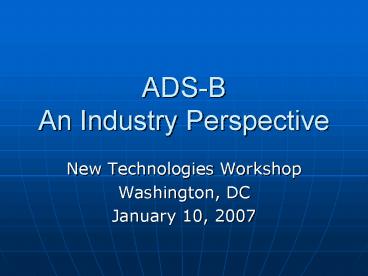ADSB An Industry Perspective - PowerPoint PPT Presentation
1 / 15
Title:
ADSB An Industry Perspective
Description:
GA (10 year equipage cycle) Commercial Aviation ( 7 year cycle) ... The Equipage Curves. The Cost Benefit story. The Consequences of Failure. Transition Plan ... – PowerPoint PPT presentation
Number of Views:84
Avg rating:3.0/5.0
Title: ADSB An Industry Perspective
1
ADS-B An Industry Perspective
- New Technologies Workshop
- Washington, DC
- January 10, 2007
2
ADS-BAutomatic Dependent Surveillance - Broadcast
- Why?
- Why so soon?
- Why does the FAA support ADS-B?
- Why might the aviation community support ADS-B?
- Why is the FAA developing a Proposed Rule for
ADS-B?
3
ADS-B Why?
- Reduce Surveillance Costs for FAA
- Surveillance applied in locations where radar
does not exist today. - Gulf of Mexico
- Mountainous Airports
- Superior update rate
- Facilitates reduced separation standards
- Facilitates future capacity enhancements
- Much of the JPDO CONOPS hinges around ADS-B type
applications.
4
ADS-B Why so soon?
- Ground Based infrastructure replenishment
decisions in the 2020 timeframe drive commitments
today. - Retrofit cycles
- GA (10 year equipage cycle)
- Commercial Aviation ( 7 year cycle)
- Assumes up to 10 years of prior development to
field the avionics - Question might be why so long?
5
ADS-BWhy does the FAA support ADS-B?
- Transition from ground based surveillance to
satellite centric operations - Divestment
- Strategic Investment decision with positive long
term cost / benefit - Support aviation community demand
- Enhances safety and capacity
6
ADS-BWhy might the aviation community support
ADS-B?
- General Aviation
- Flight Information Service Broadcast (FIS-B)
- Traffic Information System - Broadcast (TIS-B)
- Supports reduced costs imposed by FAA
- Situational Awareness and Safety enhancements
akin to current Capstone program in Alaska
7
ADS-BWhy might the aviation community support
ADS-B?
- Commercial Aviation
- Supports future reductions in separation
standards from current standards to meet
2020-2025 demand. - 5 mile enroute / 3 mile terminal separation
standards are unlikely to meet this demand - Supports future capacity enhancements
- With navigation enhancements, will benefit
arrival and departure rates - Establishes the foundation for future cockpit
safety and situational applications - VFR like separations in some cases
- Surface surveillance applications
8
ADS-BWhy is the aviation community working
through RTCA to develop recommendations for a
Proposed Rule associated with ADS-B?
- Establishes a collaborative model where FAA and
aviation community develop the future in a
collaborative manner - Road to NexGen passes through ADS-B
- Lays the foundation for future system
enhancements - Addresses many of the transition issues of
moving to a aircraft centric NAS
9
Challenges
- The Transition Plan
- The Equipage Curves
- The Cost Benefit story
- The Consequences of Failure
10
Transition Plan
- The Proposed Rule
- Accomplished in the 2007 2010 timeframe
- The Implementation Begins
- Gulf of Mexico and Eastern Seaboard
- 2010 timeframe
- The ADS-B Infrastructure
- Deployment complete in 2015 timeframe
- Benefit accrues to early equippers
- The Effectivity Date (2020 timeframe)
- Near 100 equipage is required
- Ground Based Radar removals begin
11
Equipage Curves
- G A uses a 10 year equipage cycle
- GPS or GPS / WAAS requirements
- Challenges relative to backup scenario where
surveillance source (GPS) is not available - Regional Community uses 7 year retrofit
- Lack of Inertial introduces GPS backup concerns
- Augmentation may be required
- Commercial Carriers use 7 year retrofit cycle
- Augmentation may be required
12
Cost Benefit story
- Business Case is annualized through 2035
- Pay back to FAA and to Aviation Community is not
immediate - Aviation Community ADS-B business assessment is
challenging - Lays the groundwork for future benefit
- Establishes the foundation for enhanced
Surveillance and Navigation
13
Cost Benefit story
- Fundamental Issues/Questions are
- Do you believe in the projections of at least
double current capacity in 2020 -2025? - Do you believe the transition ever goes away?
- Do you believe the service provider or the
aviation community can make fundamental, earth
changing decisions in isolation?
14
Consequences of Failure
- Do you believe in the projections of at least
double current capacity in 2020 -2025? - 100 seater projections
- 13000 today
- 27000 by 2025
- Do you believe the transition ever goes away?
- Plans and Vision are easy
- Transitions are Hard
- Do you believe the service provider or the
aviation community can make fundamental, earth
changing decisions in isolation? - JPDO vision of 2025
- Were having difficulty in delivering ADS-B out
by 2020
15
Summary
- One thing for sure, we need to move in this
direction over time. - Dont want to have to re-equip again before 2025.
- Retrofits or deliveries accomplished today need
to support 2025 applications - Dont want to change the aircraft architecture
- Dont want throw away equipment































